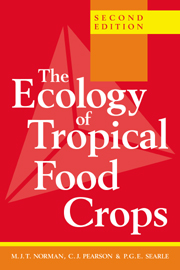2 - Tropical crop/climate relations
Published online by Cambridge University Press: 05 June 2012
Summary
Environment and its broad influences on crop growth
The relation between crop and environment is a true interaction in that it operates in both directions: the environment affects the crop and the crop modifies its environment. The effects of the crop on its environment will generally not be dealt with in this book, but it is important to appreciate that they are sometimes of major significance: for example, root growth and exploration of increasing soil volume must be described in order to predict realistic water use by crops.
Radiation
There are two atmospheric inputs which are used directly by a crop: radiation and carbon dioxide. The tropics have a year-round positive radiation balance and relatively small seasonal changes: monthly radiation during the period of highest solar angle is within 15% of that at the period of lowest solar angle. Variation in total radiation has two effects on crop growth. First, optimum plant population and potential grain yield per hectare vary with season, being higher in high-radiation, cloudless seasons than in wet or monsoon seasons. Naturally, this applies only when water is non-limiting, e.g., to irrigated rice (Fig. 5.2). Second, crop yield components and grain yield per hectare vary according to radiation received, at least during reproductive growth. Radiation influences yield components in the order in which the component is determined. For rice, the number of inflorescences per hectare is only weakly dependent on radiation (r2≃0.5), whereas the number of grains per hectare is highly sensitive to radiation until the late stages of crop growth (Evans & de Datta, 1979).
- Type
- Chapter
- Information
- The Ecology of Tropical Food Crops , pp. 21 - 45Publisher: Cambridge University PressPrint publication year: 1995



